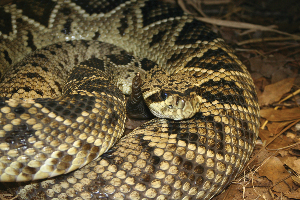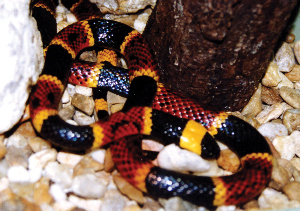Know Your Snakes
It’s the s-s-s-s-mart thing to do!
Orlando Family Magazine sat down with Nick Clark, Senior Reptile Keeper at the Central Florida Zoo, located in Sanford, Florida, to find out some valuable information regarding the most common venomous and non-venomous snakes found in Central Florida, and how to handle a snake encounter.
————-
“The first misconception people have about snakes is that they are poisonous. Snakes are venomous, not poisonous,” says Nick Clark. Snakes inject venom through a bite; they do not transfer toxins or venom through touch.
In Central Florida, there are four venomous snakes that can be found in your backyard or residing near a body of water.
Reputation: Falsely thought to have the most toxic venom.
- Habitat: Coral snakes like to keep to themselves, stay hidden, and typically live under debris, such as leaves and trash.
- Venom: A coral snake’s venom affects the nervous system and although quite potent, it is less toxic than that of an eastern diamondback rattlesnake.
- Body: The average length of a coral snake is about 20 to 30 inches and sports colorful bands of red, yellow, and black.
- Food: They like to chow down on other snakes, lizards, and frogs.
- Fun Fact: Two non-venomous snakes found in Florida, the scarlet king snake and the scarlet snake, are often mistaken for the coral snake because of their red, black, and yellow color bands.
Dusky Pygmy Rattlesnake – Most Bites Delivered in Central Florida
- Reputation: The dusky pygmy rattlesnake, also known as the “pygmy rattler,” is known for delivering more bites in Central Florida than any other venomous snake.
- Habitat: Likes a variety of terrains, but studies have shown that this type of snake usually makes its home in gopher tortoise burrows.
- Venom: The dusky pygmy rattlesnake is a member of pit viper family. Its bite is not fatal, but very painful; its venom is hemotoxic and can cause tissue damage, nausea, vomiting, and vertigo.
- Body: About 15 to 22 inches in length, these small snakes range in color from light to dark gray and have been known to have black or reddish brown spots on their body.
- Food: This snake eats small mice, lizards, and frogs.
- Fun Fact: The rattle on this snake is so small that it is very hard to see or hear, often sounding like the buzzing of a bee or a fly!

Eastern Diamond back Rattlesnake – Largest Venomous Snake
- Reputation: Reaching a length of up to eight feet, the eastern diamondback rattlesnake is the largest venomous snake found here in Florida.
- Habitat: Found predominately in wooded areas and sandy beaches, this snake likes to live in tree stumps and gopher tortoise burrows.
- Venom: Its venom is hemotoxic and considered extremely dangerous. It can cause severe tissue damage, nausea, vomiting, and vertigo.
- Body: The eastern diamondback rattlesnake ranges in length from five and a half feet to eight feet long and has distinct dark brown/black diamond shapes on its scales.
- Food: This snake lies in the shadows and waits to attack its prey, eating mice, rats, rabbits, squirrels, and birds.
- Fun Fact: Rattlesnakes shed their skin multiple times throughout the year and gain one new rattle segment with every shed!
Florida Cottonmouth – Worst Reputation
- Reputation: A cottonmouth is venomous rather than poisonous, as is widely thought. If you touch a cottonmouth, you will not get infected. The snake must bite in order for its venom to enter your body.
- Habitat: Loves to live in waterways, streams, rivers, or canals.
- Venom: With venom that is hemotoxic and deadly, cottonmouths can cause extensive tissue damage when they bite underwater.
- Body: The cottonmouth ranges from 20 to 48 inches in length and is most commonly recognized in the wild by the cream colored stripes that travel from its eyes to the back of its head.
- Food: Likes to eat small mammals, birds, and other cold-blooded prey.
- Fun Fact: The cottonmouth, also known as a water moccasin, is the only venomous water snake in North America.
———-
The most common non-venomous snakes in Central Florida are the black racer, the red rat snake, the yellow rat snake, and the water snake. “When I first began working at the Zoo several years ago, 21 snakes believed to be cottonmouths were brought in from all over the community, but none of them were venomous,” says Nick, “The snakes that were brought to the zoo were non-venomous water snakes.”
Tips for a snake encounter:
- Leave them alone. Most snakes bite when irritated, poked, or prodded.
- Contact a trained professional or call the zoo, if you have questions about the snake.
- Use the encounter as an opportunity to educate your children about snakes.
- For more information on identifying snakes, please visit the Florida Museum of Natural Science’s website: http://www.flmnh.ufl.edu/.
- Also, for information on the Central Florida Zoo, please visit: www.centralfloridazoo.org/ or call: 407.323.4450.












